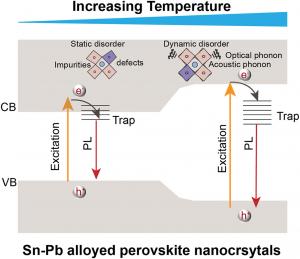Revealing the hidden enemies of light in perovskite materials
GA, UNITED STATES, June 24, 2025 /EINPresswire.com/ -- New insights into energetic disorder may help unlock the full potential of tin–lead perovskite nanocrystals (PNCs) for optoelectronic devices. Although tin alloying promises to reduce toxicity and improve air stability compared to traditional lead-based materials, its incorporation has been found to reduce light emission efficiency. This study disentangles the two primary sources of energetic disorder—static disorder from structural defects and dynamic disorder from electron–phonon interactions—and reveals how they govern photoluminescence behavior. Static disorder, strongly influenced by tin-induced lattice distortions, plays a dominant role in suppressing radiative recombination. These findings offer critical guidance for designing next-generation low-toxicity, high-efficiency perovskite emitters.
Colloidal halide perovskite nanocrystals have emerged as strong candidates for light-emitting diodes and solar applications due to their excellent photoluminescent properties. However, instability and lead toxicity limit their widespread adoption. Alloying with tin is seen as a promising strategy to address these issues, enabling broader spectral tunability and improved ambient stability. Yet, unexpectedly, increasing tin content leads to diminished photoluminescence quantum yield, suggesting more complex underlying mechanisms. The role of energetic disorder—caused by structural imperfections and thermal vibrations—has come under scrutiny. Due to these challenges, a deeper understanding of how static and dynamic disorder affect the light-emitting performance of Sn–Pb PNCs is urgently needed.
A research team from the University of Electro-Communications and collaborating institutes published their findings in January 2025 in eScience. The study investigates how energetic disorder—specifically, static versus dynamic contributions—affects light emission in tin–lead alloyed CsSnₓPb₁₋ₓBr₃ perovskite nanocrystals. By tuning Sn concentrations and employing temperature-dependent spectroscopy, the researchers identified the dominant disorder types that cause photoluminescence quenching, offering strategies to enhance optoelectronic performance.
The team synthesized a series of CsSnₓPb₁₋ₓBr₃ nanocrystals with varying tin contents and used static and transient absorption spectroscopy to distinguish static disorder (SD) from dynamic disorder (DD). They found that SD—arising from lattice strain, impurities, and Sn-induced distortions—contributed significantly more to the Urbach tail (68–118 meV) than DD, which had only minor influence. Intriguingly, while electron–phonon interactions were expected to dominate the temperature-dependent bandgap shifts, the study showed that acoustic phonon scattering, amplified by SD, governed bandgap reorganization. Carrier recombination experiments further revealed that SD leads to fast carrier trapping and shorter recombination lifetimes. The optimal Sn:Pb ratio of 2.5:1 yielded the longest lifetimes among alloyed samples, suggesting a delicate balance between Sn incorporation and structural integrity. High-resolution TEM confirmed lattice deformation and strain aligned with the photophysical findings. These results pinpoint SD as the major culprit behind reduced light emission in Sn–Pb PNCs and demonstrate how controlling lattice quality can mitigate non-radiative losses.
“Our study clarifies the long-standing debate on whether structural or thermal disorder primarily drives photoluminescence behavior in alloyed perovskites,” said Prof. Qing Shen, the study’s senior author. “By carefully dissecting the energetic contributions of static and dynamic factors, we not only uncovered the dominant role of tin-induced structural disorder but also established a clear path toward optimizing material design for future light-emitting applications.”
These findings have important implications for the development of next-generation optoelectronic materials. By demonstrating that static disorder—rather than thermal fluctuations—is the primary source of light emission losses in tin–lead perovskites, the research provides actionable insights for chemists and materials scientists. Future synthesis strategies can focus on minimizing lattice strain and impurity incorporation, for instance, through ligand engineering and dopant control. These approaches could accelerate the commercialization of lead-reduced perovskite emitters for displays, lasers, and near-infrared lighting, bridging the gap between environmental safety and high-performance functionality.
References
DOI
10.1016/j.esci.2024.100279
Original Source URL
https://doi.org/10.1016/j.esci.2024.100279
Funding information
This research was supported by JSPS MEXT KAKENHI Grant Numbers (20H02565, 17H02736), NEDO project and JST project (JPMJMI22E2).
Lucy Wang
BioDesign Research
email us here
Legal Disclaimer:
EIN Presswire provides this news content "as is" without warranty of any kind. We do not accept any responsibility or liability for the accuracy, content, images, videos, licenses, completeness, legality, or reliability of the information contained in this article. If you have any complaints or copyright issues related to this article, kindly contact the author above.

